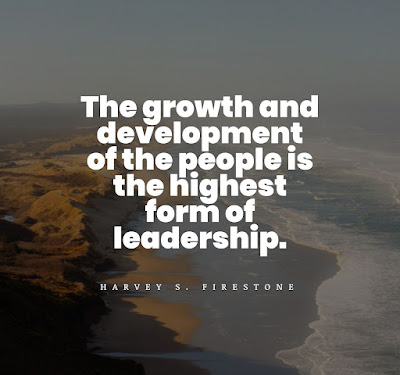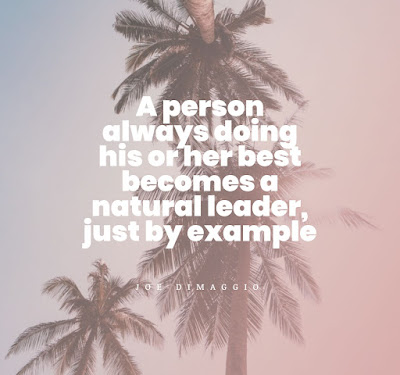DIFFERENT LEVELS OF LEADERSHIP
 |
| Different levels of Leadership |
While organizations
previously enlarged their market position gradually over time, most of them now
operate in context to the quality of leadership in the organization. The more
is the quality of leadership in the organization, the better and sustainable it
will become. The modern day businesses are much more dependent on the position
of leadership rather than individual position and skills. The reason behind
that is simply because a leader is like a lighthouse which guides their
organization depends upon the character of people in leadership in that
organization. There are different levels of leadership where a leader operates
the organization and lead people based on the level of influence they have on
them.
These levels of
influence separates leaders who just have authority from leaders who provide
and nurture the people with information, bringing them a revelation about their
life and leading them to a transformation. The purpose for the people they lead
and different leaders do it differently and therefore, they are distinguished
on the basis of influence.
John C. Maxwell is an
American author and a motivational speaker who wrote a book named “The Five
levels of Leadership” in which he explains about the various types of leaders
based on the impact they manifest on the people.
Positional Leadership
 |
| Different levels of Leadership |
“The only real training
for leadership is Leadership.”-Anthony Jay
Leaders with a position have a very narrow
influence on the people they lead. They have an impact on a very small scale
over the lives of people. Their leadership is confined just to their position
or authority over people.
Most of the leaders in
the contemporary world exercise positional type of leadership. They may be
captain or head of their football team, their university, their business
organization or even their home. Leaders in this leadership position must
recognize the limitations of their position or authority. Because of the same
reason that they do not necessarily have a huge impact on their organization
and individuals.
 |
| Different levels of Leadership |
However, whenever a
person is given a position, they have the opportunity to grow themselves a
leader and reach to higher levels of leadership. It’s important for leaders to
continually dedicate themselves to develop their leadership skills in order to
become a better leader.
Service
Leadership
 |
| Different levels of Leadership |
“Leadership is not an
affair of the head. Leadership is an affair of the heart.”-James Kouzes &
Barry Posner
The next level of
leadership after positional leadership is leadership by providing help or
service to others. People may have to obey you without their will, when you are
a positional leader for many things like their pay or to keep their job and
therefore, they ‘have to ‘ follow you although they may not “want to’.
But leaders who focus
more on understanding the needs of the people and making healthy relationships
with them fall under this category. As a result of which, people willingly do
what the leader needs to get done and always try to contribute their best to
the organization. People prefer to work with such kind of leaders who
understand them and help them rather than leaders who get things done merely by
giving orders.
This level of
leadership focuses primarily on the value of each person. All great leaders value people. They know that every individual
is unique and has some unique qualities which they can contribute to the
organization. Therefore, they treat people with care keeping in mind with their
importance. Everybody in this world wants to be treated with respect and care
whether they accept this or not. And Great leaders understand this very basic
and natural human psychology and consequently, they form good relationships
with people.
Leaders need to
understand the importance of serving, otherwise if they are too hard on people
to achieve something, there are some people in their organization only who
wants to see them fail.
Exemplary Leadership
 |
| Different levels of Leadership |
“Authority: The skill of
getting people to willingly do your will, because of your personal
influence.”-James C. Hunter
Leaders who get the
most out of people are usually the ones who lead by example. Great leaders are
themselves committed to their work. You can give all the motivational speeches
you want, but if you yourself don’t show a good work ethic and don’t apply what
you say, there’s no way that people will do the things you say. It’s important
for a leader not just to brag things on people don’t do the things that they
want their people in the company to do and make a bad example.
This level of leadership
is commonly found in military leaders but rarely found in business leaders.
That is the reason behind an organization’s failure. The job of a leaders is to
lead and you cannot lead from behind. To lead, you must set the right kind of
example that you want your people to follow. Leading by example not only brings
productivity but also creates a clear vision for the organization. It sets a
standard for the people to follow. You cannot just keep people intact with
principles and ethics until you follow them yourself.
You do not lead with
your words. You lead with your actions and your life. The kind of life you live
sets the standard for the people to follow and maintain. Therefore, it is the
responsibility of the leader to make sure that they live by the standards that
they wish to inculcate in their followers.
Developmental
Leadership
 |
| Different levels of Leadership |
“Your rewards in life
will be in direct proportion to the value of your service to others.”- Brian
Tracy
Effective leaders
understand the importance of always developing. They understand that if they
want to keep getting better at what they do, they need to commit themselves and
their team to a learning attitude. And therefore, Great leaders are life-long
learners and never stop learning till the time they die.
Steve Jobs was once
shown a prototype of the iPad and looking at it, he complained that it was too
big. When the engineers told him they couldn’t make it any smaller, Jobs took
it over to an aquarium and dropped it into the water. ‘These are air bubbles’,
he said. ‘That means there’s space in there. Make it smaller.’
This reminds us of the opportunity that we have at our work. Even though we do great work as a leader, there is always an opportunity for improvement. Great leaders never stop learning! They do not only commit to develop themselves but also others to become a better version of themselves. They are People Developers. And this is how they influence people with such immense intensity because of the connection they develop with others and inspire them to achieve great things. They know that when individuals develop themselves, they develop the organization automatically without any effort. And that is why, they work more on people rather than on organizations.
It not only provides a
chance to fulfill others goals and desires but also gives a sense of
satisfaction or fulfillment when they develop others. It takes a mature leader
to see their progress in their followers success.
Natural Leadership
 |
| Different levels of Leadership |
“A True natural servant
automatically responds to any problem by listening first.”- Robert Greenleaf
This level of
leadership is the highest level of leadership. When a leader reaches this
position of leadership, people follow them without thinking of their personal
interests because they are influenced by the passion and inspiration of the
leader. Leaders at this level do not demand ‘RESPECT’ from the people instead
they receive it without even asking for it.
Leaders at this level
have so much inculcated the qualities of good leadership that it becomes a part
of their DNA. Whenever we talk about a long-lasting organization, we are not
just discussing about the leaders that served but also the legacy that they left.
Great leaders leave an impact on the people that people are not able to forget
then even after they die. Great leaders live even after their death because of
the influence they had on people.
Leaders at this level
are so much matured in exercising their leadership over a long period of time
that they do not even have to think about what to do in a particular leadership
dilemma. They know how to handle the situation because of their prior
experience. Leaders at this level are shaped by the tough and turbulent times
that they face in their life or leadership position.
As a leader, it is your responsibility to determine at which level you are and how you can improve yourself to reach at the top. Remain humble and guide your way to the character based leadership.
REFERENCES:
1. John C. Maxwell, The five different
levels of leadership, pub. 2011
2. Anthony Jay, 100 greatest leadership
principles of all times, pg-05, pub.2007
3. James Kouzes & Barry Posner, The
Leadership Challenge, pg-06, pub.2012
4. James C. Hunter, The Servant, pg-50,
pub.1998
5. Brian Tracy, 100 Absolutely
Unbreakable laws of Business Success, pg-48, pub.2000














0 comments:
Post a Comment
Please do not enter any spam link in the comment box.